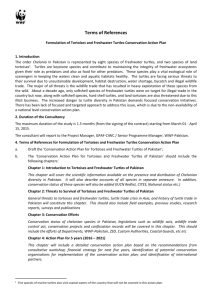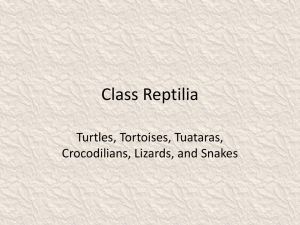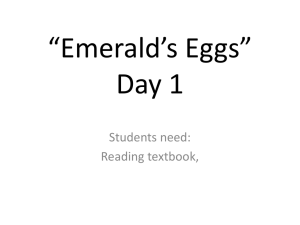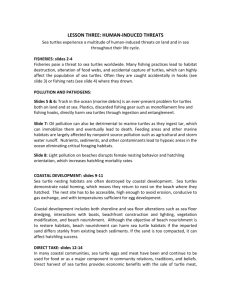Conservation Status of Southeast Asian Freshwater Turtles
advertisement
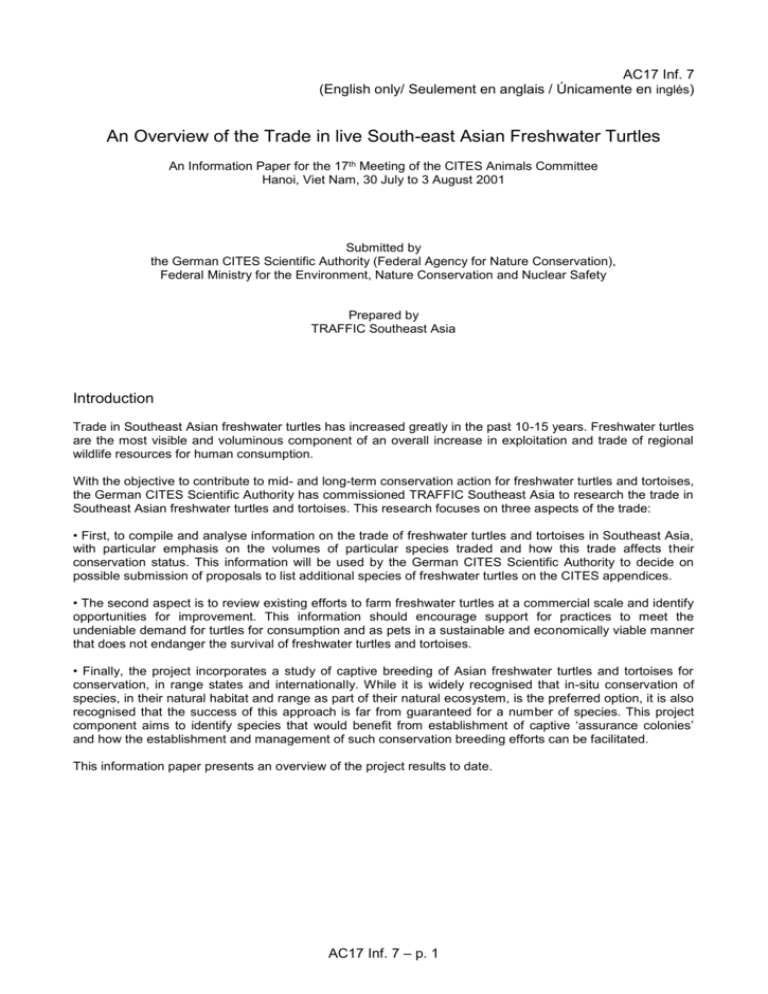
AC17 Inf. 7 (English only/ Seulement en anglais / Únicamente en inglés) An Overview of the Trade in live South-east Asian Freshwater Turtles An Information Paper for the 17th Meeting of the CITES Animals Committee Hanoi, Viet Nam, 30 July to 3 August 2001 Submitted by the German CITES Scientific Authority (Federal Agency for Nature Conservation), Federal Ministry for the Environment, Nature Conservation and Nuclear Safety Prepared by TRAFFIC Southeast Asia Introduction Trade in Southeast Asian freshwater turtles has increased greatly in the past 10-15 years. Freshwater turtles are the most visible and voluminous component of an overall increase in exploitation and trade of regional wildlife resources for human consumption. With the objective to contribute to mid- and long-term conservation action for freshwater turtles and tortoises, the German CITES Scientific Authority has commissioned TRAFFIC Southeast Asia to research the trade in Southeast Asian freshwater turtles and tortoises. This research focuses on three aspects of the trade: • First, to compile and analyse information on the trade of freshwater turtles and tortoises in Southeast Asia, with particular emphasis on the volumes of particular species traded and how this trade affects their conservation status. This information will be used by the German CITES Scientific Authority to decide on possible submission of proposals to list additional species of freshwater turtles on the CITES appendices. • The second aspect is to review existing efforts to farm freshwater turtles at a commercial scale and identify opportunities for improvement. This information should encourage support for practices to meet the undeniable demand for turtles for consumption and as pets in a sustainable and economically viable manner that does not endanger the survival of freshwater turtles and tortoises. • Finally, the project incorporates a study of captive breeding of Asian freshwater turtles and tortoises for conservation, in range states and internationally. While it is widely recognised that in-situ conservation of species, in their natural habitat and range as part of their natural ecosystem, is the preferred option, it is also recognised that the success of this approach is far from guaranteed for a number of species. This project component aims to identify species that would benefit from establishment of captive ‘assurance colonies’ and how the establishment and management of such conservation breeding efforts can be facilitated. This information paper presents an overview of the project results to date. AC17 Inf. 7 – p. 1 Trade Volumes and trends Subsistence use of freshwater turtles, and tortoises, has a long history in certain regions and among certain ethnic groups. Trade in small numbers of generally juvenile animals for the international pet trade has occurred for decades. The large-scale exploitation of adult freshwater turtles and tortoises for international commercial trade is a recent development. This international commercial trade has increased tremendously in the past decade. Precise quantities of recent trade volumes are rarely available, and if available they are frequently declared in different units (weight, number of individuals, monetary value). An approximate total trade volume can be derived from these statistics. Bangladesh exported turtles worth over US$ 8.5 million during fiscal 1996-1997. During 1997-1998, the last year for which export statistics are available, exports had declined to a value of US$ 1.7 million (Bangladesh Export Promotion Bureau 1998, in Rashid & Khan, 2000). Indonesia declared export of 828 tons representing at least 369,719 individuals in 1998 (Directorate General of Fisheries of Indonesia, in Samedi & Iskandar, 2000). However, trade observations in Sumatra estimated that at least 25 tons of live turtles were exported per week from Sumatra alone in 1999 (Shepherd, 2000); this region accounts for only one-quarter of Indonesia’s declared turtle exports, suggesting that total Indonesian exports may be at the order of 5000 tons annually. Malaysia exported a total of 2,469,504 live turtles in the first 9 months of 1999, of which 1,505,172 were captive-bred exotic species and 964,332 individuals were native species collected from the wild (Department of Wildlife and National Parks of Peninsular Malaysia, in Sharma & Tisen, 2000). Thailand showed a significant rise and fall in live freshwater turtle exports during the 1990’s, reaching a peak of over 6 million animals in 1996 but collapsing to about 470,000 animals exported during the first 7 months of 1999 (Fisheries Department of Thailand, in van Dijk & Palasuwan, 2000). The vast majority of Thailand’s turtle exports concern farmed softshells, and export numbers were significantly influenced by import restrictions in consumer countries. No quantitative data are available for turtle exports from Cambodia, Laos, Vietnam or Myanmar; export volumes are known to be substantial, however. Using conservative estimates of an average weight of 1 kg for an individual turtle and a trade value of 1 US dollar per kg, the above numbers lead to an estimate that a minimum of 13,000 metric tonnes of live turtles, or about 13 million individuals, was traded in 1999. Trade volumes are not static. Available trade statistics from Bangladesh and different regions of Indonesia show a consistent pattern of steeply increasing trade volumes for a 3-5 year period followed by a steep decrease in trade volume in the subsequent 2-3 years (Rashid & Khan, 2000; Shepherd, 2000). Species in Trade Species involved in the large-scale trade of adult freshwater turtles include almost all species of softshelled and hard-shelled freshwater turtles (families Trionychidae, Bataguridae/Geoemydidae, and Platysternidae) inhabiting the region. Species composition of trade shipments generally corresponds to species occurrence in the source region, although there are differences: Species with high trade value such as softshells are proportionally more common in the trade than in the wild, while low-value species are proportionally less traded. Table 1 presents the proportion of species exported from different countries. AC17 Inf. 7 – p. 2 Table 1: Species composition of reported trade in Freshwater Turtles by country (percentage individuals) Species Indonesia 1998 Sumatra99 quota traded Malaysia (1999) Thailand (1999) Viet Nam (‘94-’99) n/incl 37.6 % 14.3 % 8.8 % 5.5 % 7.3 % 18.4 % 4.2 % Wild-collected Amyda cartilaginea Dogania subplana Pelochelys cantorii Cuora amboinensis Cuora galbinifrons Cyclemys dentata Heosemys grandis Heosemys spinosa Malayemys subtrijuga Notochelys platynota Orlitia borneensis Pyxidea mouhotii Siebenrockiella crassicollis n/incl 9.2 % 61.3 % 14.6 % 4.9 % 0.3 % - 3% 3% 47 % 17 % 1% 9% 14 % 0.36 % 0.17 % 18.49 % 13.17 % 0.50 % 0.89 % 5.47 % - - 50.77 % 10.18 % 100 % - Farmed Pelodiscus sinensis Trachemys scripta - - Note: Columns do not necessarily add to 100% since certain species may be traded but are not included in this table. Sources: Samedi & Iskandar, 2000; Shepherd, 2000; Sharma & Tisen, 2000, Hendrie, 2000. Trade Routes The trade in live Freshwater Turtles follows a variety of routes, originating from the various countries supplying the international trade and converging on the major cities and trade hubs of southern East Asia. Corresponding to the increasing trade volumes originating from particular source areas followed by subsequent decrease in trade volume, trade routes increase and decrease in significance over time. Conservation Status of Southeast Asian Freshwater Turtles The 2000 IUCN Red List includes conservation status assessments of 89 species of Asian turtles. Of these 89 species, 67 species are listed as threatened, meaning CR, EN or VU. 21 species are considered LR:nt and LR:lc, or DD (table 2). This is a remarkable increase from the 1996 IUCN Red List, which listed only 33 Asian Turtle species as threatened (table 3). Also remarkable is that not a single species was considered at less risk in 2000 than in 1996. AC17 Inf. 7 – p. 3 Table 2. Asian Freshwater Turtles and Number of species listed in each category of threat IUCN Red List Categories EX CR EN VU LR: nt LR: lc DD Extinct Critically Endangered Endangered Vulnerable Lower Risk, near threatened Lower Risk, least concern Data Deficient Total Tortoises in the IUCN Red List 1996 5 7 21 12 22 18 2000 1 18 27 22 6 9 6 0.0 % 5.9 % 8.2 % 24.7 % 14.1 % 25.9 % 21.2 % 85 100 % 1.1 % 20.2 % 30.3 % 24.7 % 6.7 % 10.1 % 6.7 % 89 100 % Note: discrepancy between total number of Asian species in 1996 and 2000 Red Lists is due to taxonomic changes (new / resurrected species) Table 3. Asian Freshwater Turtles and Tortoises in the IUCN Red List Changes in threat assessments between 1996 and 2000 Red List Unchanged Increased by 1 category of threat Increased by 2 categories Increased by 3-5 categories Decreased in threat New evaluations (including previous DD and LR: lc) Total Species 25 24 6 4 0 Percent 28.1 % 27.0 % 6.7 % 4.5 % 0.0 % 30 33.7 % 89 100.0 % Trade Impacts on Freshwater Turtle Populations Threats to the conservation of Asian Freshwater Turtles come from a variety of causes. These can broadly be categorised as general habitat degradation processes impacting turtles as unintentional side effects, and targeted exploitation of turtles by humans, for subsistence consumption and / or trade. How significant are these various threats ? Of the 18 Asian turtle species listed in the 2000 IUCN Red List as ‘Critically Endangered’, habitat degradation impacts are a factor for 7 species while exploitation is listed as a cause of endangerment for 15 species (Table 4). Of course, several species suffer from both habitat degradation and direct collection: for example, while coastal creeks and nesting beaches have been degraded extensively in its range, the main reason that Batagur baska is considered CR is because of its population decline resulting from intensive long-term collection of eggs. Similarly, of 27 species listed as Endangered, habitat impacts feature for 11 species while direct exploitation is involved for 19 species. Of the 21 Vulnerable species, 10 are in decline at least partly because of habitat degradation, and 17 species are in decline resulting from direct targeted exploitation. AC17 Inf. 7 – p. 4 Table 4. Asian Tortoises and Freshwater Turtles Number of species impacted by categories of threat Number of species in category A1 Recent Population Reduction A1a – observed A1b – abundance index A1c – range/habitat reduction A1d – exploitation A1e – competition, disease etc. A2 Future Population Reduction A2b – abundance index A2c – range/habitat reduction A2d – exploitation A2e – competition, disease etc. B Restricted-Range species B1 – fragmented populations B2 – declining population(s) B3 – fluctuating population(s) C Low Population numbers C1 – declining C2 – fragmented D Very small adult population E Extinction Probability Analysis in the 2000 IUCN Red List CR 18 EN 27 VU 21 1 7 15 - 1 18 22 1 1 1 10 17 - 4 13 - 11 19 - 7 15 - 4 4 - 5 5 - 3 3 - 1 1 - - 1 - - - Why are turtles so sensitive to exploitation ? Turtles have evolved a specialised life history. Natural mortality of eggs and hatchlings is high. It takes many years, often decades, to reach full adult size and maturity. Once this full size is reached, however, the surviving individuals are almost invulnerable to natural predators and can reproduce steadily over many years or decades. By collecting these ecologically invulnerable adults, humans with the use of fire and tools have broken the security of this evolutionary strategy. And because of the often low annual reproductive output and high natural mortality of eggs and young, the time needed for a turtle population to recover, if left alone, still would be in the order of decades or centuries. Intensive targeted exploitation of commercially valuable species inhabiting a limited geographical area has brought a number of species to endangered or critically endangered status. Among these are Mauremys annamensis of central Viet Nam, Cuora trifasciata and Mauremys mutica of northern Viet Nam and southern China, Cuora aurocapitata, C. mccordi, C. pani, C. zhoui and Chinemys nigricans of China, Heosemys (Leucocephalon) yuwonoi of northern Sulawesi, Indonesia, and Orlitia borneensis of southern Peninsular Malaysia, Borneo and Sumatra, Indonesia. In addition, the various species of the genus Heosemys (H. grandis in mainland SE Asia; H. spinosa in insular SE Asia; H. leytensis in the Philippines; and H. depressa in Myanmar) are extensively traded and are endangered or are expected to reach endangered status in the near future. Preliminary review of the available trade and conservation information has led the German CITES Scientific Authority to provisionally select the genus Heosemys and the species Mauremys annamensis, Leucocephalon yuwonoi, Mauremys mutica and Orlitia borneensis for further investigation of their meeting the criteria for inclusion in CITES Appendix II as set out in Res. Conf. 9.24. AC17 Inf. 7 – p. 5 Farming of Freshwater Turtles for the Consumption Trade Commercial farming of freshwater turtles, specifically the Chinese Softshell Pelodiscus sinensis, to supply the consumption trade was developed in Japan at the end of the 19 th century and further developed in Taiwan, Thailand and elsewhere in recent decades. Production of farmed softshells reached a peak in Thailand, Malaysia and Taiwan in the mid- to late 1990’s, reaching annual production and export of over 6 million individuals in Thailand in 1996 (van Dijk & Palasuwan, 2000) and over 1.5 million in Taiwan in 1997 (Chen et al., 2000). Following this peak, the industry receded as demand in and access to the main consumer market, southern China, declined. The reasons for this are not fully clear but involve import bans based on pathogens carried by stock farmed outside China and presumably competition from domestic farming operations. Consequently, wholesale export prices were significantly reduced in Thailand and Malaysia, leading to a reduction in farming activities at present. Commercial farming exists of two species of hard-shelled turtles, the Red-eared Slider Trachemys scripta which is native to the United States, and the Chinese Stripe-necked Turtle Ocadia sinensis native to temperate East Asia. Both species are farmed in quantities of tens to hundreds of thousands of animals annually (Chen et al., 2000; Sharma & Tisen, 2000). These species are predominantly farmed to supply the pet trade, but farmed Trachemys scripta elegans have appeared in East Asian food markets in increasing quantities, indicating that farming of hard-shelled turtles is cemoning economically worth-while in competition with wild-collected freshwater turtles. Conservation Breeding of Threatened Freshwater Turtle Species Captive breeding of Asian turtle species has occurred in zoos and among the animals maintained by devoted hobbyists for about 30 years. These efforts generally derived from individual people’s interest and devotion, but apart from sharing information on maintenance techniques and conditions through literature, such efforts generally occurred in isolation. With the realisation of the conservation situation of Asian freshwater turtles, the need became clear for coordinated conservation breeding programs. Efforts are underway globally to establish captive ‘insurance’ colonies of Asian turtle species, to ensure survival of species at least in captivity when in-situ conservation of the species in its natural habitat may not be feasible or assured of success. Coordination of such efforts was facilitated significantly by the formation of the Turtle Survival Alliance following a workshop on conservation breeding of endangered Asian freshwater turtles and tortoises held in Ft. Worth, USA, in January 2001. It is expected that the TSA will stimulate conservation breeding success by facilitating information sharing, facilitating exchange of captive stock and raising awareness of the value of conservation breeding. Literature Cited Chen, Tsien-Hsi, Hua-Ching Lin and Hsien-Cheh Chang. 2000. Current Status and Utilisation of Chelonians in Taiwan. Pp. 45-51 in Asian Turtle Trade: Proceedings of a Workshop on Conservation and Trade of Freshwater Turtles and Tortoises in Asia (van Dijk, Stuart & Rhodin, eds.). Chelonian Research monographs, Number 2. Convention on International Trade in Endangered Species of Wild Fauna and Flora. 1994. Resolution of the Conference of the Parties 9.24: Criteria for Amendment of Appendices I and II. van Dijk, Peter Paul, Bryan L. Stuart and Anders G. J. Rhodin (eds). 2000. Asian Turtle Trade: Proceedings of a Workshop on Conservation and Trade of Freshwater Turtles and Tortoises in Asia. Chelonian Research monographs, Number 2. 164 pp. van Dijk, Peter Paul, and Thanit Palasuwan. 2000. Conservation Status, Trade, and Management of Tortoises and Freshwater Turtles in Thailand. Pp. 137-144 in Asian Turtle Trade: Proceedings of a Workshop on Conservation and Trade of Freshwater Turtles and Tortoises in Asia (van Dijk, Stuart & Rhodin, eds.). Chelonian Research monographs, Number 2. Hendrie, Douglas B. 2000. Status and Conservation of Tortoises and Freshwater Turtles in Vietnam. Pp. 6373 in Asian Turtle Trade: Proceedings of a Workshop on Conservation and Trade of Freshwater Turtles and Tortoises in Asia (van Dijk, Stuart & Rhodin, eds.). Chelonian Research monographs, Number 2. Rashid, S. M. A., and S. M. Munjurul Hannan Khan. 2000. Trade and Conservation Status of Freshwater Turtles and Tortoises in Bangladesh. Pp. 77-85 in Asian Turtle Trade: Proceedings of a Workshop on Conservation and Trade of Freshwater Turtles and Tortoises in Asia (van Dijk, Stuart & Rhodin, eds.). Chelonian Research monographs, Number 2. Samedi, and Djoko T. Iskandar. 2000. Freshwater turtle and Tortoise Conservation and Utilisation in Indonesia. Pp. 106-111 in Asian Turtle Trade: Proceedings of a Workshop on Conservation and Trade of AC17 Inf. 7 – p. 6 Freshwater Turtles and Tortoises in Asia (van Dijk, Stuart & Rhodin, eds.). Chelonian Research monographs, Number 2. Sharma, Dionysius S. K., and Oswald Braken Tisen. 2000. Freshwater turtle and Tortoise Utilisation and Conservation Status in Malaysia. Pp. 120-128 in Asian Turtle Trade: Proceedings of a Workshop on Conservation and Trade of Freshwater Turtles and Tortoises in Asia (van Dijk, Stuart & Rhodin, eds.). Chelonian Research monographs, Number 2. Shepherd, Chris R. 2000. Export of Live Freshwater Turtles and Tortoises from North Sumatra and Riau, Indonesia: A Case Study. Pp. 112-119 in Asian Turtle Trade: Proceedings of a Workshop on Conservation and Trade of Freshwater Turtles and Tortoises in Asia (van Dijk, Stuart & Rhodin, eds.). Chelonian Research monographs, Number 2. Acknowledgements Preparation of this paper was supported by the German Federal Agency for Nature Conservation with funds from the Federal Ministry for the Environment, Nature Conservation and Nuclear Safety, under project FKZNr. 801 86 080. The implementation of the project is facilitated by WWF Germany under project WWF 2101/0340.05 and is managed by TRAFFIC Southeast Asia as project SEA 107.00.1010. The assistance and support of these organisations is gratefully acknowledged. AC17 Inf. 7 – p. 7

